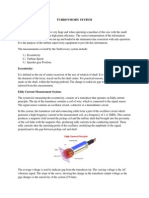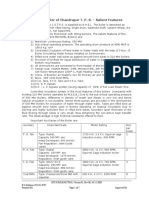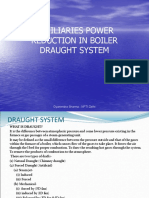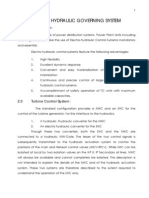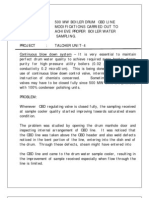0 ratings0% found this document useful (0 votes)
282 viewsTurbo Supervisory System
The document discusses the Turbo Supervisory System used in modern steam turbines. It monitors critical parameters like casing expansion, differential expansion, axial shift, speed, valve positions, and vibrations. Inductive transducers are used to accurately measure these parameters and initiate alarms or trips if limits are exceeded. The system helps ensure safe and reliable turbine operation under varying operating conditions.
Uploaded by
Jagadeesan SaiCopyright
© © All Rights Reserved
Available Formats
Download as PDF, TXT or read online on Scribd
0 ratings0% found this document useful (0 votes)
282 viewsTurbo Supervisory System
The document discusses the Turbo Supervisory System used in modern steam turbines. It monitors critical parameters like casing expansion, differential expansion, axial shift, speed, valve positions, and vibrations. Inductive transducers are used to accurately measure these parameters and initiate alarms or trips if limits are exceeded. The system helps ensure safe and reliable turbine operation under varying operating conditions.
Uploaded by
Jagadeesan SaiCopyright
© © All Rights Reserved
Available Formats
Download as PDF, TXT or read online on Scribd
You are on page 1/ 41
1
TURBO SUPERVISORY SYSTEM
1.0 Introduction:
The ever-growing demand for electricity is forcing the power industry to look
for new technologies. This is essential to make plant availability as high as
possible under a safe operating environment. Certain critical parameters such
as Differential Expansion, Vibration etc., are to be necessarily monitored for
high speed rotating equipment. Accurate measurement and on line
monitoring of Critical parameters of Turbine and initiating the necessary alarms
and trips are done by the Turbo Supervisory System in modern steam turbines.
The equipments for the above system for the Turbines of Units 4 to 7/Stage-
II/TPS-II were supplied by M/S BHEL.
2.0. Critical Parameters Of Turbine:
The monitors of Turbo Supervisory System perform the following functions:
a. They convert the output of the transducers into usable signals
depending upon the purpose for which they are required.
b. They actuate alarms and trips, when some preset operating limit is
exceeded
The following critical parameters of Turbine are measured and monitored:
1. Thermal Expansion of Turbine casing related to a fixed point. (Casing
Expansion)
2. Differential Expansion between the rotor and the casing of the
Turbine
3. Axial Displacement of Turbine rotor relative to Thrust bearing (Axial
shift)
4. Rotational Speed of Turbine
5. Valve positions (Stop Valves & Control Valves)
6. Vibrations in one or more points of support of Turbo generator
7. Turbine bearing metal temperature.
The points of measurements of turbo supervisory system are as shown in
figures 1A & 1B and they are detailed in Table-I
2
3
4
5
6
S.No Parameter
measured
Type of Pick-up Location of the
Pick-up
I CASING
EXPANSION
1 HP casing
expansion
Inductance (Rope
and
Cam
arrangement)
HPT front bearing
Pedestal
2 IP casing
expansion
Inductance (Rope
and Cam
arrangement)
HPT rear bearing
Pedestal
II DIFFERENTIAL
EXPANSION
1 HP differential
expansion
Inductance
(non contact type)
Adjacent to HPT
Front bearing
2 IP differential
expansion
Inductance
(non-contact
type)
On coupling between
IP and LP rotor
3 LP differential
expansion
Inductance
(non-contact
type)
On coupling between
LP & Gen rotor
III AXIAL SHIFT Inductance
(non-contact
type)
On coupling between
HP & IP rotor
IV SPEED OF TURBINE Halls effect Adjacent to gear
coupling of MOP
V VALVE POSITION
1 HP control valves Inductance (Rope
and cam
arrangement)
Respective valves
7
2 IP control Valves
3 LP bypass control
valves
VI RELATIVE
VIBRATION OF TG
SHAFT
1 HP turbine front Eddy current
(non-contact
type)
Adjacent to HPT front
bearing
2 HPT rear Adjacent to Thrust
bearing
3 IPT rear Adjacent to IPT rear
bearing
4 LPT rear Adjacent to LPT rear
bearing
VII ABSOLUTE
VIBRATION OF
BEARING PEDESTAL
1 HPT front Seismic Mass
(Contact type)
Pickups are provided
just above the
respective shaft
vibration pick-ups
2 HPT rear
3 IPT rear
4 LPT rear
5 Generator Front
6 Generator Rear
VIII TURBINE BEARING
METAL
TEMPERATURE
Ni Cr Ni
Thermo couples
8
1 HP front Top L, Top-R Bot-L,
Bot-R (4 nos)
2 HPT rear Top L, Top-R Bot-L,
Bot-R (8 nos) Front &
Rear
3 IPT rear Bot-L, Bot-R (2 nos)
4 LPT rear Front-Bot Right,
Rear Bot Right (2nos)
5 Generator Front Front-Bot Right,
Rear Bot Right (2nos)
6 Generator Rear Bearing Liner (2nos)
3.0. Inductive Transducers:
Inductive transducers are those in which the self-inductance of a coil or the
mutual inductance of a pair of coils is altered in value due to variations in the
value of the quantity under measurement.
The measuring principle is based on the fact that the impedance of a coil
with iron core depends on the size of air gaps in the magnetic circuit. The
curve of the characteristic ie., Impedance as a function of the air gap is
shown in fig: 2(a). The characteristic almost has the shape of hyperbola. It has
its maximum value when the air gap is zero and approaches a value called
Basic Impedance Zero as the air gap becomes larger. This strongly bent
characteristic is very steep when the air gaps are small. When the air gap
becomes larger, no measuring effect can be observed.
A measuring set up comprising 2 coils are shown in fig: 2(b). If there is a
relative displacement of the shaft with respect to the housing (in a turbine), the
air gaps d
1
and d
2
between measuring disc at the shaft and the 2-coil cores
change and the inductances L
1
and L
2
thus change as well but inversely. If the
displacements are small, the change in inductance is approximately
proportional to the change in the air gap.
9
10
These 2 coils L
1
and L
2
are connected to form a measuring bridge as shown
in fig: (2c). A fixed a.c voltage is fed to the bridge across the terminals (2) and
(4).
For a particular position of the collar of the turbine shaft, the air gaps d
1
and
d
2
are identical. Hence the bridge is in balanced/equilibrium. When the bridge
is in balanced state, there is no potential difference across the terminals (1)
and (3).
When the turbine shaft changes its position, the air gaps between the coils
L
1
and L
2
and the collar will vary. This varies the inductance of the coils L
1
and
L
2
resulting in unbalancing of the bridge. Hence a potential difference exists
between the terminals (1) and (3) and this output voltage is processed as
measured quantity. The characteristic of this measuring set up i.e., the output
voltage as a function of air gap is shown in fig: 2(d). The characteristic is
almost linear in the area of passage through zero and this area is used for
measuring the quantity.
This type of inductance transducers i.e., non-contact type is used for HP, IP,
LP differential expansions and axial shift of Turbine.
Inductance type transducers (contact type) are used for measuring HP, IP
casing expansions, HP, IP control valve positions and LP bypass control valve
positions.
4.0. Casing Expansion:
Whenever any metal is heated up, it tends to expand in all directions. In the
same way, when the steam is being admitted into turbine, both the rotor and
the cylinder expand. The cylinder and the rotor of the turbine are supported in
such a way that they are free to expand thermally.
Absolute thermal expansion of the turbine cylinder with reference to its fixed
point is referred to as Casing Expansion.
11
12
The fixed points of 210 MW turbine casing are as shown in the fig: 3. Supports
for the turbine casing are as detailed below.
IP rear pedestal and LP rear pedestal are anchored rigidly over the
concrete foundation. Since IP casing and LP casing are supported on these
pedestals, they act as absolute fixed points for the respective casings.
Moreover the middle of the LP turbine outer casing is supported on the
concrete foundation through key and key-ways (Left & Right). Thus the middle
point of LP turbine outer casing acts as absolute fixed point for thermal
expansion. This facilitates thermal expansion of one half of LP outer casing
towards IP turbine end and the other half towards the generator end. Since IP
rear pedestal and LP rear pedestal are fixed points the thermal expansion of
both halves of LP turbine outer casing (with reference to middle fixed point)
towards both the ends is accommodated by stainless steel bellows provided
for this purposes.
HP front and rear pedestals are located on the concrete foundation with a
sliding support. HP outer casing is seated over these two pedestals.
IP outer casing is seated over HP rear pedestal (sliding support) and IP rear
pedestal (fixed support).
4.1 IP Turbine Casing Expansion:
IP turbine outer casing, on heating, will expand towards HP turbine end
with reference to IP rear pedestal as fixed point. IP turbine casing thermal
expansion hence results in physical movement of HP rear pedestal. Hence, the
pick up of IP turbine casing expansion is located on the bedplate of HP rear
pedestal.
13
4.2 HP Turbine Casing Expansion:
HP turbine outer casing, on heating, will expand towards HP front
pedestal with reference to IP rear pedestal as fixed point. But the effect of IP
turbine casing expansion will be super imposed on HP turbine casing
expansion. The pick up of HP turbine casing expansion is located on the
bedplate of HP front pedestal. Hence the value measured by this pick up will
be a total of HP turbine and IP turbine casing expansions and it is not an
absolute thermal expansion of HP casing alone.
The transducer used for measuring HP/IP turbine casing expansion is of
inductance type (contact type). The part which is subject to a linear
movement and whose movement is to be measured ie: HP front pedestal for
HP casing expansion / HP rear pedestal for IP casing expansion is connected
by a rope to a rotatable measuring device called as CAM as shown in figure:
(4). This measuring device (cam) forms the magnetic return path for the two
sensor coils. The linear movement of the HP front/rear pedestal will be
transmitted as a rotary movement of the cam through the rope. The air gaps
between the cam and the coils depend on the angle of rotation. As the air
gaps vary due to the rotation of the cam, the output voltage of the bridge will
also vary.
5.0. Differential Expansion:
Differential expansion is the difference in the thermal expansions of the
rotor and the casing. Differential expansion = Rotor expansion Casing
expansion
The phenomenon of differential expansion is encountered during start up
and initial pick up of load and differential contraction on occasions of sudden
load throw off.
14
Differential expansion is said to be positive, when the total expansion
exceeds that of the casing and vice versa.
The rate of expansion / contraction of the rotor is faster than of the casing
because of the following reasons:
(i) The mass of the rotor is less, compared to the mass of the casing,
which is heavy.
(ii) The rotor is rotating in full jacket of steam while the inner portion of the
casing alone is exposed to the steam.
(iii) The shell thickness of the casing is more and this accounts for the slow
rate of expansion / contraction of the casing.
The value of the differential expansion tends to increase while starting and
loading and also during unloading and tripping of the turbine. Since the rotor is
revolving with very close clearances with stationary components of the casing,
an uncontrolled differential expansion would prove to be unsafe for the
turbine. This is because; such a condition may lead to rubbing, vibration and
consequent damage to the equipment. Hence continuous monitoring of the
values of the differential expansion of all the turbine cylinders becomes
necessary.
Differential expansion is measured at three points viz HP differential
expansion, IP differential expansion and LP differential expansion.
The turbo-generator rotor is supported by a double collar combined journal
and thrust bearing located in HP rear pedestal and 5 journal bearings in total.
The thrust bearing acts as a fixed point for the rotor and with reference to that
point the rotor can expand thermally on both directions (towards generator
end and HP front pedestal end). Since the HP rear pedestal itself is located
with a sliding support, the fixed point for the rotor is relative only.
15
The fixed points for the casing and the rotor shown in figure (3). It may be
observed that the inner casings of HP, IP and LP turbines are supported in their
respective outer casings in such a way that both the rotor and the casing
expand in the same direction in all three cylinders.
5.1 HP Turbine Differential Expansion:
Transducer of the HP differential expansion is located in the HP front
pedestal adjacent to the journal bearing in such a way that it measures the
linear movement of a measuring disc / collar which is provided in the HP rotor.
The linear movement of the measuring disc is due to the following thermal
expansions.
(i) Since the IP casing expansion leads to physical movement of the HP
rear pedestal, the thrust bearing itself is subjected to a movement
towards the HP front pedestal end and hence the entire rotor itself.
Hence the measuring disc is also subjected to an equivalent physical
movement towards the HP front pedestal end.
(ii) Direction of HP rotor expansion with reference to the thrust bearing
(fixed point) of the rotor is towards the HP front pedestal end and the
measuring disc hence moves towards HP front pedestal end due to
HP rotor expansion
(iii) Since the transducer is mounted on HP front pedestal, the effect of
HP and IP casing expansions together will result the movement of the
transducer towards the HP front pedestal end.
The net liner movement of the measuring disc due to the above 3 effects is
measured by the transducer as HP Differential Expansion.
The transducer is of Inductance type (non-contact type). A measuring set
up comprising 2 coils as shown in fig: 5 is provided. If there is a relative
displacement of the rotor with respect to the casing ie, due the differential
16
17
18
expansion, the air gaps d
1
and d
2
between the measuring disc (in the rotor)
and the two coils will change. Thus the inductances L
1
and L
2
change as well
but inversely.
The coils are connected to form a measuring bridge as shown in fig: 5.
Alternating current is fed to this bridge, which is in equilibrium when the air
gaps are the same. The output voltage of the measuring set-up depends on
the changes of the air gaps and this will be measured as HP differential
expansion.
5.2 IP Turbine Differential Expansion:
Transducer for the IP Turbine differential expansion is located in the IP rear
pedestal adjacent to Hydraulic turning gear in such a way that it measures the
linear movement of a measuring disc/collar which is provided in the IP/LP
rotors coupling itself. The linear movement of the measuring disc is due to the
following thermal expansions:
1. Since the IP casing expansion leads to physical movement of the HP rear
pedestal, the thrust bearing itself is subjected to a movement towards
the HP front pedestal end and hence the entire rotor itself. Hence the
measuring disc is also subjected to an equivalent physical movement
towards the HP front pedestal end.
2. Direction of IP rotor expansion with reference to the thrust bearing (fixed
point) of the TG rotor is towards the Generator end and the measuring
disc hence moves towards the Generator end due to IP rotor expansion.
3. The transducer is mounted on IP rear pedestal and it is not subjected to
any physical movement, as IP rear pedestal is the absolute fixed point for
the casing.
The net linear movement of the measuring disc due to the above 3 effects is
measured by the transducer as IP Differential Expansion. The transducer is of
19
Inductance type (non-contact type), which is explained in sec: 5.1 for HP
Differential Expansion.
5.3 LP Turbine Differential Expansion:
Transducer for measuring the LP turbine differential expansion is located in
the LP rear pedestal at the coupling between the Generator rotor and the LP
rotor. The face of the coupling itself is of a double cone shape and the
transducer measures the linear movement of the double cone. The linear
movement of the double cone is due to the following thermal expansions:
1. Since the IP casing expansion leads to physical movement of the HP rear
pedestal, the thrust bearing itself is subjected to a movement towards
the HP front pedestal and hence the entire rotor itself. So the measuring
double cone is also subjected to equivalent physical movement towards
the HP front pedestal end.
2. Direction of LP rotor expansion with reference to the thrust bearing (fixed
point) of the rotor is towards the Generator end. The effect of IP rotor
expansion will be superimposed on LP rotor expansion since both the
rotors are coupled together. So the measuring cone moves towards the
Generator end due to LP rotor expansion as well as IP rotor expansion.
3. The transducer is mounted on LP rear pedestal and it is not subjected to
any physical movement, as the LP rear pedestal is the absolute fixed
point for the LP turbine casing.
The net linear movement of the measuring cone due to the above 3 effects
is measured by the transducer as LP Differential Expansion.
The transducer is of Inductance type (non contact type). A measuring set
up comprising of 2 coils arranged obliquely is shown in fig: 6. Generally the
transducers meant for differential expansion measurements are positioned
20
parallel to the rotor collar, but in the double cone arrangement adopted here,
the measuring cone makes an angle of 15 deg with the horizontal line.
The transducer is positioned parallel to this angled face at a distance a.
Now let b be the actual displacement to be measured.
Then a = b sin = b sin 15
= 0.25 b
For a cone angle of = 15 , an axial displacement of results in an air
gap change of a, which is equal to 0.25 b. Thus the large changes in
displacement can thus be reduced to relatively small changes in the air gaps.
6.0 Axial Shift of Turbine:
The axial shift of turbine rotor is the physical shift of rotor due to the
action of any unbalanced axial thrust on it.
The axial thrust experienced by the multistage rotor in the direction of
steam flow depends on the rate of steam flow and pressure drop in the moving
blades in various stages of the Turbine. When the steam passes through the
moving blades of a reaction stage, the rotor experiences an axial thrust due to
pressure drop across the moving blades.
The cumulative axial thrust on the rotor needs to be balance exactly so
that the rotor acquires a correct and fixed position in its dynamic condition.
The shift of the rotor takes place when an unbalanced condition sets in. The
rotor spins at a very high speed; the moving blades and the fixed blades are in
very close proximity to each other and the clearances at the labyrinth glands
are also very small. Such conditions naturally warrant that the rotor position
should be very much exact. A shift of the rotor to an impermissible extent leads
to, rubbing at the labyrinth glands and blades, vibrations and finally failure.
Hence a close watch on the axial shift is warranted.
21
The IP and LP turbine stages are of double flow type. Hence the axial
thrust gets balanced automatically since the rate of steam flow and the
amount of pressure drop across the stages are opposite and equal. In HP
cylinder, which is of single flow type, the rotor would experience cumulative
axial thrust due to the pressure drop in all the stages of the moving blades. This
cumulative axial thrust is balanced by the provision of a Balance Piston.
To maintain proper axial position and to take up any unbalanced axial
thrust, the turbo-generator rotor is positioned and supported by a double collar
thrust bearing located in the HP rear pedestal. In the thrust bearing, 2 collars
which are integral with the rotor, rotate between the thrust shoes made up of
segments and thus they are supported. The clearance between the collar and
the shoes is small and the bearing is lubricated by forced circulation of lub oil. If
the rotor starts to move in either direction (due to unbalanced condition), the
axial thrust is transmitted to the shoes through the lub oil film.
Transducer for measuring the axial shift of the turbine rotor is located in
the HPT rear pedestal adjacent to the thrust bearing in such a way that it
measures the linear movement of a measuring disc provided in the coupling
outer surface between HP and IP rotors. Since the thrust bearing acts as a fixed
point for the rotor, the thermal expansion of the rotor here is zero. Hence the
effect of thermal expansion of the rotor will not affect the position of the
measuring disc. Movement of this measuring disc is only due to physical shift of
the rotor (due to unbalanced axial thrust). The transducer thus measures true
physical axial shift of the rotor.
The transducer is of Inductance type (non contact type), which is similar to
the one, explained in sec: 5.1 for HP differential expansion.
22
7.0 Turbine Speed:
The speed of a turbine is a measure of revolutions in unit time and it is
measured as revolutions per minute. The operating speed of turbine is 3000
rpm.
Measurement and monitoring of the speed of turbine will be necessary
for the following:
i. For automatic control of the turbine control valves for speed raising
during start-up
ii. During normal operation, the optimum speed of the turbine is to be
maintained.
iii. To help the operator to run the turbine at an optimum speed during
emergencies such as load shedding, grid disturbances etc.,
iv. To achieve accurate speed control when the generator feeding only
to its unit auxiliaries (house load condition).
v. For conducting the over-speed test.
Transducer for the measurement of turbine speed works on the principle
of Hall Effect and it is called Hall probe. This Hall probe is located in the HPT
front pedestal at the coupling end of main oil pump adjacent to Hydraulic
speed transducer (Governor Impeller)
7.1 Hall Effect:
In this principle, a semiconductor plate is placed as a probe and
supplied with a constant current I as shown in fig: 7 when a transverse
magnetic field is applied, it produces an output voltage V
H
is proportional to
the flux density B of the transverse magnetic field. If a permanent magnet is
attached to a moving object, the reluctance of internal magnetic circuit gets
23
changed with the changes in the distance between the object and the probe.
This leads to changes in the flux density. As this probe converts the magnetic
flux density into a proportional voltage, all the characteristic parameters of flux
densities changing in time can also be measured.
7.2 Measurement of Speed:
In this arrangement, a non-magnetic disc is fitted with 120 small magnets
of alternating polarity around its circumference. The disc is mounted on the
24
25
shaft by means of the hub ring at the coupling end side of main oil pump. Four
Hall Effect generators (Hall probes) are placed opposite at a small distance
from the pole surface of the disc as shown in Fig: 8. These probes are of
contact less type and three out of four probes are used here. When the turbine
rotor is in rotation, the reluctance of the magnetic circuit gets changed
alternately and hence the flux density. This leads to the generation of an
alternating voltage whose frequency is proportional to the speed of the
turbine rotor.
7.3 Generation Of Actual Speed Signal:
The output signal of each Hall-effect generator is approximately
sinusoidal and its frequency is proportional to the speed of the turbine. The
output signal of each Hall probe is passed to a separate pulse converter. Each
of these pulse converters amplifies the Hall effect voltage and multiplies to
form 3 square wave signals. One of the 3 signals of each pulse converter is
routed to pulse amplifiers.
A pulse monitor continuously monitors the 3 output signals of the pulse
amplifiers for failures. This is implemented by cyclical scanning of the input
pulses. The second signal in the chronological order is selected in the channel
selection circuit as the actual speed signal and supplied to a
frequency/voltage converter. In this frequency/voltage converter, the square
wave signals are converted into analog signals.
The above arrangement is needed for reliable and accurate measurement
of speed. Fixed control current is supplied to the Hall probes from the pulse
converter.
8.0 Valve Position:
Superheated steam from the boiler is supplied to the HP turbine through
2 main steam lines. Each main steam line is having a set of HP Stop Valves
26
(HPSV) and HP Control valve (HPCV) just before HP turbine. The HP turbine
exhaust steam (Cold Reheat Steam) is taken to the reheater through two Cold
Reheat Lines. The reheated steam is sent to the IP turbine through two hot
reheat lines. A set of IP stop valve (IPSV) and IP Control Valve (IPCV) is
available in each hot reheat line. The exhaust steam of IP turbine is flowing to
the LP turbine through two cross around pipes. Finally the exhaust steam of the
LP turbine is sent to the condenser.
HPSVs and IPSVs are meant for instantaneous isolation of the turbine from
the boiler in case of turbine tripping. HPCVs and IPCVs are used to regulate the
steam flow into the turbine.
Indications about the position of the above mentioned turbine valves are
helpful for the turbine operation Engineer to understand the existing condition
of the turbine. Valve positions need to be monitored due to the following
reasons:
a. To verify whether the turbine generators execute their controlling
functions effectively.
b. To supervise the healthiness of each valve.
c. To observe and record the positions thereby knowing the operating
status of turbine.
d. To raise the speed of the turbine and also to control it while starting up
e. To check whether all the turbine valves have got closed during tripping
of turbine.
f. To monitor behaviour of these whenever sudden grid disturbances
occur.
The transducer for measuring the valve position is of Inductance type
(contact type). The part which is subject to a linear movement, whose
27
movement is to be measured, ie, valve stem is connected by a rope to a
rotatable measuring disc called as CAM as shown in Fig: 4. This measuring
device is similar to that explained in sec: 4.2 for the measurement of HP/IP
casing expansions.
ith the above type of transducer, the positions of the following valves are
measured:
i. HP control valve (Left)
ii. HP control valve (Right)
iii. IP control valve (Left)
iv. IP control valve (Right)
v. LP bypass control valve (Left)
vi. LP bypass control valve (Right)
9.0 Vibrations:
All bodies possessing mass and elasticity are subjected to vibration. The
rotating machines are to be designed in such a way that the vibration levels
are acceptable. Reliability of Turbo-Generators performance depends greatly
upon the level of vibration. Higher level of vibration results in fast wear out of
components such as rotor, bearings, couplings etc. Since the vibration is an
application of alternating forces, it will result in catastrophic failure of the
components due to fatigue and the failure of stationary structures such as
bearing supports, bolts, foundation, pipings etc.
9.1 Causes Of Vibration:
Vibration in a rotating turbo-machine is mainly due to the unbalance.
The Rotor unbalance is the result of unequal radial weight distribution and it is
due to the geometric centre line not coinciding with the mass centre line. Such
28
an unbalance creates a centrifugal force that deflects the rotor. It results in
radial displacement of the rotor. A rotor is said to be perfectly balanced when
its mass distribution is such that the summation of all the centrifugal forces is
zero and the summation of the moments of these forces about the centre of
gravity is also zero.
Turbine rotors are manufactured with a high degree of precision. Still
some residual unbalance, it unavoidable. Main causes of Unbalance in a
new rotor are usually due to the factors such as machining tolerances,
assembly procedures etc. During operation, this unbalance results in vibrations,
which are transmitted through the bearing and the bearing pedestal on to the
foundation.
For the rotors, which are in service, Bow or Deflection is the cause of
unbalance. Some of the causes of shaft Bow are hereunder:
1. Lengthy horizontal turbine rotors, which are supported in one
position, for a long period after shut down, may develop bow. This
is due to non-uniform distribution of its weight along the rotor.
2. During shut down, a bow may develop in the rotor because of
non-uniform distribution of heat.
3. Rubbing in glands and seals will cause hot spots, which can bow
the rotor.
4. The weight shifts on rotor.
5. The loss of rotating elements.
6. Unequal building of silica deposits on the rotor.
Hence the perfect balance of the rotor is warranted to avoid high level
of vibrations.
Some other causes of vibration for new as well as old rotors are as follows:
29
1. Misalignment of rotors due to improperly seated bearings.
2. Mechanical looseness at the supports.
3. Oil whirl in the fluid film bearings (oil whirl is caused by the instability of
the rotor supported in the fluid film)
9.2 Critical Speed:
All rotating machine components have more than one natural
frequencies of oscillation; the frequencies at which they will vibrate
enormously. When the speed of rotation is nearing its natural frequency, even
a small amount of unbalance in rotor causes unacceptable vibration leading
to resonance. The speed of the rotor is known as CRITICAL SPEED. At these
critical speeds only, all the unbalanced forces in the rotor resonate and create
maximum amplitude of vibration. Above or below each critical speed,
resonant effects diminish. Hence the turbo machines are designed such that
the natural frequencies do not coincide with the operating speed.
9.3 Need Of Measurement:
Vibration measurement and monitoring are warranted due to the following
reasons:
1. It is useful to diagnose the healthiness of the turbine to avoid failure. Any
change in quiet running means a deterioration of the balanced state of
the rotor.
2. It is useful to assess the units operating time between major overhauls.
3. It is useful to locate the failing component in the machine. A blade
rupture may cause a sudden change in quiet running.
30
4. It is useful to correlate with probable failures by having history of vibration
data as a function of changes in the process parameters such as load,
temperature etc.
5. It is useful to estimate how much longer a machine can be safely run by
observing the trend in vibration level
When the normal operating speed of the turbine rotor is less than its first
critical speed, the rotor is said to be a rigid rotor. When its normal operating
speed lies above its first critical speed, the turbine rotor is said to be a flexible
rotor. The critical speed values of 210 MW turbine rotors (Units 4 to 7 / TPS-II) are
indicated below:
CRITICAL SPEED (in rpm):
HP rotor IP rotor LP rotor Gen. Rotor Combined
1 First critical speed 4230 3858 1818 1370 1544
2 Second critical speed >3600 >3600 >3600 3400 2126
9.4 Absolute Vibration of Bearing Pedestal:
Pick-up used for measuring absolute vibration of bearing pedestal is of
SEISMIC MASS TYPE (contact type). This type is a velocity transducer. In this, the
mechanical vibration is converted to an electric signal which is proportional to
the velocity of the vibration.
The fig: 9 shows the schematic diagram of absolute vibration
measurement by means of a seismic device. In this device, a plunger coil is
suspended in an air gap. A permanent magnet is firmly connected to the
sensor housing and to the magnetic return path and it provides a strong
magnetic field around the coil. The magnetic flux in the air gap is constant.
31
32
The plunger coil is suspended from the housing by a spring. The inherent
frequency of the spring/mass is
= 2f = (c/m)
1/2
where m is mass of the plunger coil with spring and C is the spring constant.
When the vibrating frequency is above the inherent frequency, the
plunger coil is steady in space due to its mass inertia. Thus a fixed point in
space is created and the vibrations can be measured with reference to this
point.
Whenever this transducer (seismic device) is firmly connected to the
surface of the vibrating item to be measured, a relative motion is generated
between the permanent magnet and the plunger coil. When the permanent
magnet vibrates and the spring-suspended coil is stationary in space, the coil
cuts magnetic lines of force resulting in generation of voltage.
The voltage is proportional to the vibration velocity (the rate of
vibration); the strength of the magnetic field, and the number of turns of wire in
the coil.
e = B.l.v
Where e is Induced voltage,
B is magnetic induction of the permanent magnet,
l is length of the conductor in the coil and
v is rate of vibration velocity.
A seismic velocity transducer responds directly to the velocity of
vibration. The voltage generated in a seismic velocity transducer is normally
expressed in terms of milli volts per mm per second. This is the sensitivity
33
specification for the pick up. The sensor, provided here, generates 20mV for a
vibration velocity of 1 mm/sec.
The amplitude of vibration is usually indicated rather than the rate of
vibrations. This is achieved by integrating the sensor output voltage, which is
proportional to the rate of vibrations.
9.5 Relative Vibration of Shaft:
Relative shaft vibration is the radial periodic motion of the shaft with
respect to the bearing or casing. Radial shaft position is the position of the shaft
with respect to the bearing or casing and depends on the operating state of
the turbine and on the condition of the bearings. The range within which the
radial shaft position may change is very much greater than the vibration travel
amplitude of the shaft. The relative vibration is thus superimposed over the
change of the radial shaft position.
The measurement is carried out in a contact less manner according to
the eddy current method. A non-contact sensor requires external electronic
circuitry to generate a very high frequency a.c signal and detect vibrations in
the a.c signal caused by the vibration of the shaft.
The electronic circuit, called a signal sensor, generates a very high
frequency electrical signal. This signal is applied to a small coil of wire in the tip
of the non-contact pick-up. The high frequency electric signal applied to the
coil generates a magnetic field. This electro magnetic alternating field
generated induces eddy currents in any metallic object in the vicinity of the
coil, namely the turbine shaft (whose vibration is to be measured). The smaller
the distance between the sensor coil and the turbine shaft, these eddy
currents are larger. Due to this, the turbine shaft absorbs some of this magnetic
energy. This absorption effect places an electrical load on the electrical
signal, thereby reducing its strength. The amount of loading-reduction in
strength-is inversely proportional to the distance the coil and the shaft. The
34
closer the coil to the shaft, the greater the loading effect and the smaller the
amount of electrical signal.
As the shaft moves relative to the tip of the pick up, the strength of the
electrical signal changes proportional to the movement. The variation in the
strength of the electrical signal is thus proportional to the amount of vibration
and is further processed.
Schematic diagram of non-contact pick-ups is shown in the fig: 10. The
signal sensor consists of a high frequency oscillator, an amplitude detector
(Demodulator) and an amplifier.
When the incoming supply is ON, the transducer starts working. The
oscillator generates a very high frequency electrical signal, which is applied
through a cable to a small coil of wire in tip of the pick up. The variation in the
strength of this electric signal occurs as explained earlier and it is proportional
to the amount of vibration.
The amplitude modulated high frequency electric signal of the
transducer is demodulated by the amplitude detector to give a d.c voltage
signal proportional to the gap (the distance between the tip of the transducer
and the shaft is called Gap) and an a.c. signal voltage proportional to
vibration. These signals are then amplified to a high level to give usable output
voltages.
10. Measurement Of Temperature - Thermocouple (Ref Fig: 11)
Thermocouple is the temperature-sensing device widely employed for
industrial applications. In steam turbines, they are used for measuring metal
and steam temperatures in addition to bearing temperature.
A thermocouple is composed of 2 dissimilar metal wires joined together
at their ends. It is a device that converts temperature difference directly into
an electric voltage when a temperature gradient exists between the two end
35
36
37
junctions of the pair of dissimilar metal wires. One end is fused together to for a
measuring junction called as the hot junction and the other end, the cold
junction or the reference junction and are connected to a measuring device.
The temperature at the hot junction is determined by measuring the voltage
appearing at the cold junction. The voltage developed is a function of the
difference in temperature between the hot and the cold junctions. Hence the
temperature of the cold end junction must be accurately known.
The desirable properties of thermo couples for industrial use are
i Relatively large thermal e m f
ii Precision of calibration
iii Resistance to corrosion and oxidation.
iv Linear relation of emf to temperature.
In order to prevent the forming of a second hot junction, the wires of
thermo couples are insulated from each other.
Ni-Cr-Ni Thermo couples are provided for measuring turbine bearing
metal temperature for the following (Ref. Fig. (12), (13) & (14)
1. HP front journal bearing - Top/Left, Top/Right, Bottom/left &
Bottom/Right (4 Points)
2. HP rear thrust bearing - Top/Left, Top/Right, Bottom/left &
Bottom/Right, Front Side & Rear Side
(8 Points)
3. IP rear journal bearing - Front & Rear (2 Points)
4. LP rear journal bearing - Front & Rear (2 Points)
5. Generator front journal - Front & Rear (2 Points)
Bearing
38
S.No. Conditions Values
1. Speed:
Maximum speed for continuous operation. 51.5Hz
Minimum speed for continuous operation 47.5 Hz
2. Turbo Generator Bearing Metal Temperature:
Alarm Value Trip Value
a) Bearing Number 1 HPT Front 90 C 100 C
b) Bearing Number 2 HPT Rear 90 C 100 C
c) Thrust Bearings 90 C 100 C
d) Bearing Number 3 IPT Rear 100 C 110 C
e) Bearing Number 4 LPT Rear 100 C 110 C
f) Bearing Number 5 Generator Front 100 C 110 C
g) Bearing Number 6 Generator Rear 80 C 90 C
3. Turbine Bearing Vibrations: Alarm Value "Trip Value"
a) Absolute Brg Vibration in (0 Peak) 35 45
b) Absolute Shaft Vibration in (0 Peak) 120 200
4. Differential Expansion: Upper Limit Lower Limit
a) HP Differential Expansion. + 5 - 3.5
b) IP Differential Expansion. + 6.5 - 2.0
c) LP Differential Expansion. + 30 - 9
39
40
41
You might also like
- Turbine & Its Governing and Turbo Generator Alok100% (6)Turbine & Its Governing and Turbo Generator Alok143 pages
- CH 7 Paper 5 Flue Gas Temp Optimisation - Vindhyachal - ActualNo ratings yetCH 7 Paper 5 Flue Gas Temp Optimisation - Vindhyachal - Actual6 pages
- Classification, Working and Construction Features of Conventional Boiler and Pressure PartsNo ratings yetClassification, Working and Construction Features of Conventional Boiler and Pressure Parts107 pages
- Industrial Training Project Report (SECURED) PDFNo ratings yetIndustrial Training Project Report (SECURED) PDF192 pages
- Dokumen - Tips Coordinated Master Control in Thermal Power PlantNo ratings yetDokumen - Tips Coordinated Master Control in Thermal Power Plant40 pages
- Turbovisory Instruments Gyanendra Sharma Npti Delhi100% (2)Turbovisory Instruments Gyanendra Sharma Npti Delhi81 pages
- How To Deal Emergencies in Thermal Power Plant0% (1)How To Deal Emergencies in Thermal Power Plant4 pages
- Research in Varying Burner Tilt Angle To Reduce Rear Pass Temperature in Coal Fired BoilerNo ratings yetResearch in Varying Burner Tilt Angle To Reduce Rear Pass Temperature in Coal Fired Boiler9 pages
- Jindal Power Limited, Tamnar: JPL/OPN-250/SOP/.. 01/29.07.2019 00/00No ratings yetJindal Power Limited, Tamnar: JPL/OPN-250/SOP/.. 01/29.07.2019 00/004 pages
- Technical Data For The Bhel 500 MW Steam TurbineNo ratings yetTechnical Data For The Bhel 500 MW Steam Turbine2 pages
- Ads A TG Integral Block Speed B 100 S B 3000 2900 - X T MIN MAX I SNo ratings yetAds A TG Integral Block Speed B 100 S B 3000 2900 - X T MIN MAX I S5 pages
- Draught System Gyanendra Sharma NPTI Delhi100% (3)Draught System Gyanendra Sharma NPTI Delhi24 pages
- Unit Shut Down Procedure Gyanendra Sharma NPTI Delhi100% (1)Unit Shut Down Procedure Gyanendra Sharma NPTI Delhi41 pages
- Report of Unchahar Unit 2 Bearing 6 VibrationNo ratings yetReport of Unchahar Unit 2 Bearing 6 Vibration8 pages
- Air Pre Heater Gyanendra Sharma NPTI DelhiNo ratings yetAir Pre Heater Gyanendra Sharma NPTI Delhi56 pages
- Modification in 500MW CBD Line For Proper Boiler Water SamplingNo ratings yetModification in 500MW CBD Line For Proper Boiler Water Sampling54 pages
- Jindal Power Limited.: Design & Feature of 600 MW Steam TurbineNo ratings yetJindal Power Limited.: Design & Feature of 600 MW Steam Turbine70 pages
- 15ecl48 VTU LIC LAB Raghudathesh Adder Integrator and Differentiator50% (4)15ecl48 VTU LIC LAB Raghudathesh Adder Integrator and Differentiator14 pages
- Design of Low Noise Amplifier For Microwave Circuits: July 2017No ratings yetDesign of Low Noise Amplifier For Microwave Circuits: July 20175 pages
- GETinvest Market Insights - ZMB - Mini Grid - CS Solar - 2019 1No ratings yetGETinvest Market Insights - ZMB - Mini Grid - CS Solar - 2019 18 pages
- (PwrElect - Linear and SMPS) Sams-Solid State Power Supplies and Converters (1978 Electronics) PDFNo ratings yet(PwrElect - Linear and SMPS) Sams-Solid State Power Supplies and Converters (1978 Electronics) PDF58 pages
- "Minimum kVAR of The Capacitor Needed" - Google SearchNo ratings yet"Minimum kVAR of The Capacitor Needed" - Google Search1 page
- 12.smoothing Reactor & Reactive Power Control of HVDC System50% (4)12.smoothing Reactor & Reactive Power Control of HVDC System32 pages
- Transmission & Distribution Sector - PACRA Research - Jan'23No ratings yetTransmission & Distribution Sector - PACRA Research - Jan'2313 pages
- Calculation of 750kV Transmission Line Parameters Based On ATP-EMTP SimulationNo ratings yetCalculation of 750kV Transmission Line Parameters Based On ATP-EMTP Simulation4 pages
- Rectifier Diodes BYQ28X Series Ultrafast: General Description Quick Reference DataNo ratings yetRectifier Diodes BYQ28X Series Ultrafast: General Description Quick Reference Data6 pages
- Symmetrical and Unsymmetrical ComponentsNo ratings yetSymmetrical and Unsymmetrical Components5 pages
- Ultra-Low-Power, 10Msps, Dual 8-Bit ADC: General Description FeaturesNo ratings yetUltra-Low-Power, 10Msps, Dual 8-Bit ADC: General Description Features22 pages
- Predator Morlock Board Programming ManualNo ratings yetPredator Morlock Board Programming Manual3 pages
- CH 7 Paper 5 Flue Gas Temp Optimisation - Vindhyachal - ActualCH 7 Paper 5 Flue Gas Temp Optimisation - Vindhyachal - Actual
- Classification, Working and Construction Features of Conventional Boiler and Pressure PartsClassification, Working and Construction Features of Conventional Boiler and Pressure Parts
- Dokumen - Tips Coordinated Master Control in Thermal Power PlantDokumen - Tips Coordinated Master Control in Thermal Power Plant
- Turbovisory Instruments Gyanendra Sharma Npti DelhiTurbovisory Instruments Gyanendra Sharma Npti Delhi
- Research in Varying Burner Tilt Angle To Reduce Rear Pass Temperature in Coal Fired BoilerResearch in Varying Burner Tilt Angle To Reduce Rear Pass Temperature in Coal Fired Boiler
- Jindal Power Limited, Tamnar: JPL/OPN-250/SOP/.. 01/29.07.2019 00/00Jindal Power Limited, Tamnar: JPL/OPN-250/SOP/.. 01/29.07.2019 00/00
- Ads A TG Integral Block Speed B 100 S B 3000 2900 - X T MIN MAX I SAds A TG Integral Block Speed B 100 S B 3000 2900 - X T MIN MAX I S
- Unit Shut Down Procedure Gyanendra Sharma NPTI DelhiUnit Shut Down Procedure Gyanendra Sharma NPTI Delhi
- Modification in 500MW CBD Line For Proper Boiler Water SamplingModification in 500MW CBD Line For Proper Boiler Water Sampling
- Jindal Power Limited.: Design & Feature of 600 MW Steam TurbineJindal Power Limited.: Design & Feature of 600 MW Steam Turbine
- 15ecl48 VTU LIC LAB Raghudathesh Adder Integrator and Differentiator15ecl48 VTU LIC LAB Raghudathesh Adder Integrator and Differentiator
- Design of Low Noise Amplifier For Microwave Circuits: July 2017Design of Low Noise Amplifier For Microwave Circuits: July 2017
- GETinvest Market Insights - ZMB - Mini Grid - CS Solar - 2019 1GETinvest Market Insights - ZMB - Mini Grid - CS Solar - 2019 1
- (PwrElect - Linear and SMPS) Sams-Solid State Power Supplies and Converters (1978 Electronics) PDF(PwrElect - Linear and SMPS) Sams-Solid State Power Supplies and Converters (1978 Electronics) PDF
- "Minimum kVAR of The Capacitor Needed" - Google Search"Minimum kVAR of The Capacitor Needed" - Google Search
- 12.smoothing Reactor & Reactive Power Control of HVDC System12.smoothing Reactor & Reactive Power Control of HVDC System
- Transmission & Distribution Sector - PACRA Research - Jan'23Transmission & Distribution Sector - PACRA Research - Jan'23
- Calculation of 750kV Transmission Line Parameters Based On ATP-EMTP SimulationCalculation of 750kV Transmission Line Parameters Based On ATP-EMTP Simulation
- Rectifier Diodes BYQ28X Series Ultrafast: General Description Quick Reference DataRectifier Diodes BYQ28X Series Ultrafast: General Description Quick Reference Data
- Ultra-Low-Power, 10Msps, Dual 8-Bit ADC: General Description FeaturesUltra-Low-Power, 10Msps, Dual 8-Bit ADC: General Description Features




